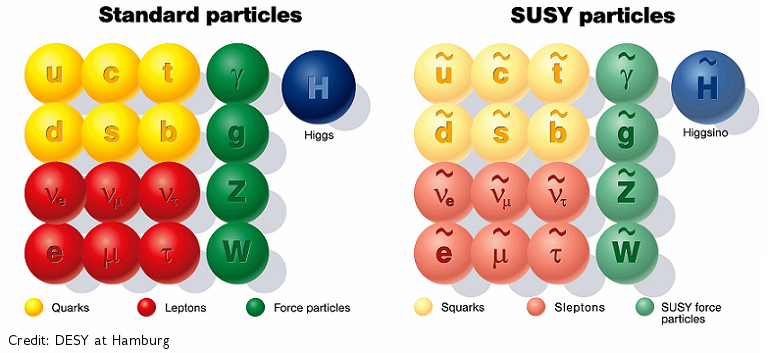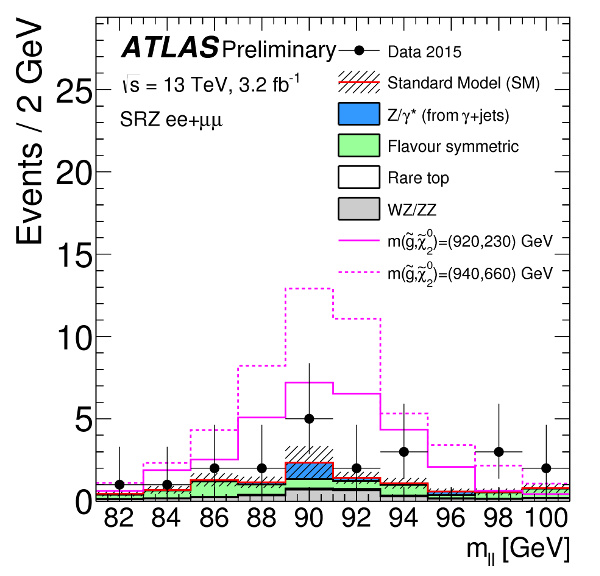Symmetrising Forces and Matter
 The interplay between theories and discoveries since the beginning of the 20th century have led to an outstanding apprehension of what the universe is made of: a few basic building blocks called fundamental particles, governed by four fundamental forces. The description of the relations between these elementary notions is codified in the Standard Model of particle physics.
The interplay between theories and discoveries since the beginning of the 20th century have led to an outstanding apprehension of what the universe is made of: a few basic building blocks called fundamental particles, governed by four fundamental forces. The description of the relations between these elementary notions is codified in the Standard Model of particle physics.
Over time and through many experiments, the Standard Model has become established as a well-tested physics theory. Yet the model has its shortcomings: among others, it does not explain dark matter or dark energy, which jointly make up 95 per cent of the universe. Nor is it compatible with Einstein's theory of general relativity; the force of gravity as we know it does not seem to work at the subatomic quantum scale. A third issue is that the Standard Model does not protect the Higgs boson mass, and as a consequence if there exist heavier particles than the ones we know today –and we have reasons to think that is the case– then such particles may couple to the Higgs field and pull up its mass to values much heavier than those measured.
Supersymmetry, or SUSY, is one of the alternatives proposed for explaining these inconsistencies, postulating the existence of a heavier "partner" for every particle in the universe. By doubling the number of particles, there is a cancellation between processes with ordinary particles only and processes with their superpartners, thus fixing the mass of the Higgs boson. In addition, Supersymmetry actually makes the unification of three other forces, strong, weak, and electromagnetic, also a reality: the strengths of the three forces become equal within a per-cent-level at very high energies. Last but not least, in Supersymmetry the lightest superpartner is predicted to be stable and electrically neutral and to interact weakly with the particles of the Standard Model. These are exactly the characteristics required for dark matter, thought to make up most of the matter in the universe and to hold galaxies together.
So where are the superpartners? It is a realistic hope that the experiments operating on the Large Hadron Collider (LHC) at CERN, Geneva, Switzerland will find them. If created at the proton-proton collisions at LHC, they would eventually decay to the lighter superpartner, which –thanks to its dark-matter properties– would escape through the detectors unnoticed. Yet, it would carry away energy and momentum, so physicists could only infer their existence from the imbalance of energy and momentum after a collision – the so-called “missing energy.” Consequently, should SUSY be realised in Nature, one would expect to observe at LHC a surplus of events, an excess, on top of the ones expected from known Standard Model processes, when selecting events with large missing energy plus other particles. The latter are determined by the specific theoretical supersymmetric model and superpartner decay chain targeted in each analysis in such a way so as to achieve a sample enriched in SUSY events.

No definite evidence for Supersymmetry has been detected so far at the LHC, however one of the two excesses observed by the ATLAS experiment with the first Run-2 data taken during 2015 concerns a search for Supersymmetry. Quoting a recent CERN Courier article dedicated on the first ATLAS results with 13 TeV collisions, “The first [excess], with a significance of 2.2 standard deviations, was seen in the search for SUSY with gluino production with subsequent decays into a Z boson and missing energy; a 3 standard-deviation excess was observed in this channel in Run 1.” The SUSY subgroup of IFIC in the ATLAS experiment, led by Dr Vasiliki Mitsou, had initiated the Run-1 search on the 20.3 fb-1 of data taken at a proton-proton collision energy of 8 TeV and played a major role in carrying out the analysis, which finally yielded the 3σ excess. The group is currently actively involved in the follow-up search on the Run-2 data at an increased energy of 13 TeV. The first 3.2 fb-1 of data, recorded by ATLAS in 2015, have already showed that the excess indeed persists at the level of 2.2σ rendering the observation profoundly interesting.
These intriguing results have given rise to diverse proposals attempting to provide plausible explanations for the observed excess of Z bosons mostly within the context of supersymmetric theories. Researchers at IFIC have published such a study following a bottom-up approach outlining the phenomenological profile of non-minimal SUSY models that may reproduce the experimental findings.
Unarguably, it is too early to declare that an overabundance of Z bosons has been observed in events selected to target signals of SUSY. Much more data are required to be collected and analysed before such a claim is made. In 2016 the amount of data to be recorded by ATLAS is anticipated to be around ten times more than in 2015, enough to provide a definite answer whether this excess is a mere statistical fluctuation of known physics or due to new phenomena. Test proton-proton collisions for 2106 are already proceeding at the LHC with the first physics data expected to come soon. Stay tuned for more to come.
"A search for supersymmetry in events containing a leptonically decaying Z boson, jets and missing transverse momentum in √s = 13 TeV pp collisions with the ATLAS detector", ATLAS Collaboration. ATLAS-CONF-2015-082 (2015)
"METing SUSY on the Z peak”, G. Barenboim, J. Bernabeu, V.A. Mitsou, E. Romero, O. Vives. Eur.Phys.J. C76 (2016) 2, 57, arXiv:1503.04184
“Latest ATLAS results with 13 TeV proton–proton collisions at the LHC”. CERN Courier, January-February 2016, p. 8-9
















